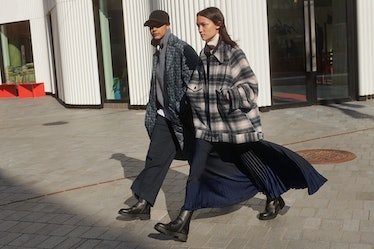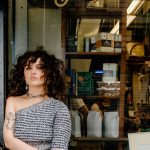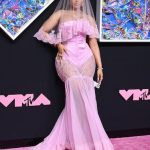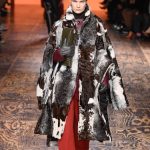In April of 2020, Clare Waight Keller left her post as creative director of Givenchy, where she designed both women’s ready-to-wear and couture. Over the course of just three years, the British designer managed to have a huge impact. She was the first woman to ever hold the title at the house, and she won the approval of critics and celebrities alike, most notably designing Meghan Markle’s wedding dress in 2018. But, after her previous stints at Gucci, Pringle of Scotland, and Chloé as well, it was time for her next chapter. “Love and creativity remain central to what I do, and who I am, as does a heartfelt belief in kindness, and the courage to be true to your art,” she wrote in her note of departure at the time.
And then the pandemic happened, and Waight Keller ended up taking a whole year off. When she got back to London, Uniqlo came calling, and a partnership with the brand seemed like the right next step. A fan of Jil Sander’s Uniqlo +J collaborations in the past, Weight Keller now also finds herself in company with names like Jonathan Anderson, Christophe Lemaire, and Ines de la Fressange. Her refined, modern-feminine aesthetic brings a breath of fresh air to the brand, as well as an haute couture touch. Ahead of the collection’s launch on September 15, we spoke with Waight Keller about shopping in the men’s section, layering with HeatTech, and, of course, trenchcoats.
What was your relationship to Uniqlo before collaborating with the brand?
The brand came on my radar when they did their first launch of a collaboration with Jil Sander. Because I was a huge fan of Jil and her work, it got me interested in what they were doing. After that, I became a customer. So I’ve shopped the brand for about ten years, particularly in the men’s department: men’s sweaters or oversize men’s shirts. Even today, I still have those pieces and they still look fantastic.
Looks from Clare Waight Keller’s Uniqlo collection.
Courtesy of Uniqlo x Clare Waight Keller
How did you approach the collaboration process?
This was the first time I was completely independent of a brand. Even though it was under the Uniqlo umbrella, the brief was totally open. I went back into my own wardrobe and my own British roots because that was a natural place for me to start. It was a super-edited collection—only 35 pieces—so I had to be quite decisive. Each piece had to have a reason for being, in terms of its ability to coordinate with the other pieces, and add something to the silhouette. I tried to get that through the color, fabric, and the fit.
When you looked at your own wardrobe, was there anything you noticed? Has it changed at all since COVID, leaving and starting a new job, etc.?
Yeah, totally. I was off for about a year after I left Givenchy, and during that time it was the heaviest part of the pandemic. We were all isolated and didn’t know where anything was going to go. When I came back to London and got a phone call from Uniqlo, it was interesting to me because, personally, I felt that everyone had—in my sphere, anyway—changed the way they work and their work-life balance. There was just a real lack of needing to be dressed up. I also felt, though, that you didn’t want to look like you were just in (leggings) all day long. So the idea of this crossover between casual and chic felt really relevant to me.
I had a lot of chic pieces in my wardrobe, and some of them still have relevance, but a lot of the other ones felt like, Oh, that would be good for a cocktail party or a night out, but it’s not really what I’m going to wear to work. Whereas, a couple of years ago, it would have been. What are the pieces in my wardrobe that I’ve had for ten years, that I keep going back to? That fit into this new way of living as well? That’s when I landed upon the trenchcoat, the shirt, the corduroy blazer suit, the fluid pleated skirts.
A look from Clare Waight Keller’s Uniqlo collection.
Courtesy of Uniqlo x Clare Waight Keller
What are the personal touches or details you’ve added to those pieces, like the trench coat, for example?
The trench coat is an iconic, versatile, go-to early autumn piece that’s inherently British. It was important to think about the different climates that Uniqlo sits among: even though it might be cold in England come the end of September, it’s still 30 degrees Celsius (86 degrees Fahrenheit) in Asia. So I wanted lightness to be really a big part of it. The belt is extra-long so you can tie it multiple ways. The sleeve has got an extra drop underneath it so you can layer a gilet or an ultralight down piece as you get towards winter. It’s got these lovely cuffs that you can belt in for a more feminine silhouette. The lining’s got a beautiful check that then I echoed with the nylon piece. I like this idea that there’s multifunctionality to everything.
As for the flowy dresses, they look great with a heat turtleneck underneath it with boots, or you can wear the lemon color next spring and it will feel super light and fresh.
Waight Keller working on the Uniqlo collection in her studio.
Courtesy of Uniqlo x Clare Waight Keller
It seems like a nice balance of traditionally masculine and feminine elements. Is this something you were thinking about when designing?
Definitely. I wanted to get that femininity across. Uniqlo as a brand is so brilliant at technology and innovation—and it’s quite utilitarian. I wanted the femininity to come through in my capsule collection for them because it’s an area that they haven’t necessarily tapped into, but it’s a strength of mine.
How would you describe the “British” sensibility you mentioned earlier?
In London, you could go through four seasons within a single day. So there’s the sensibility of always being able to take layers off, and put layers on. And also that they are shower-proof. These British quirks, I guess, are an integral part of what I do—but also the color. The British are quite good at wearing color and mixing it, layering it, contrasting it. It’s something that, coming to Japan, I realize is quite unique because here they love neutral clothing.
Did it feel like a jump going from couture to Uniqlo?
There are definite challenges in terms of achieving the price, but that was really the only difficult part. The brand was so open to understanding new techniques of finishing. I showed them examples of, this is how the spaghetti string that runs through the dresses should look; this is how it should balance. A lot of the things I did on a constant basis whilst I was in Paris are techniques that I was able to distribute through the collection as well. It’s just an innate way of working, or what I’ve absorbed over the years.
Looks from Uniqlo x Clare Waight Keller.
Courtesy of Uniqlo x Clare Waight Keller
Are you already looking ahead to next season?
Well, I’m on season three already. Even though we’ve only just launched in the stores, it’s been, like, 18 months that I’m working with them. That’s the interesting part of it—because they only do two collections a year, you have this six month period to really develop the entire season very carefully. There are going to be more things added as I go along and—maybe, fingers crossed—menswear. We’ll see.
Do you miss the fashion calendar at all? Or are you okay to leave it behind?
I’m still looking at everything popping up on my social media. So I don’t feel necessarily not a part of it. I was in Paris last week and I saw so many people that I work with and friends from my past there. I think Uniqlo actually can be part of the fashion cycle. People dip in and out of that store all the time. I mean, I’ve got so many friends who are like, Oh my God, I can’t believe you’re working at Uniqlo. It’s sort of a hidden fashion secret. So I don’t feel like I’m that far away.



